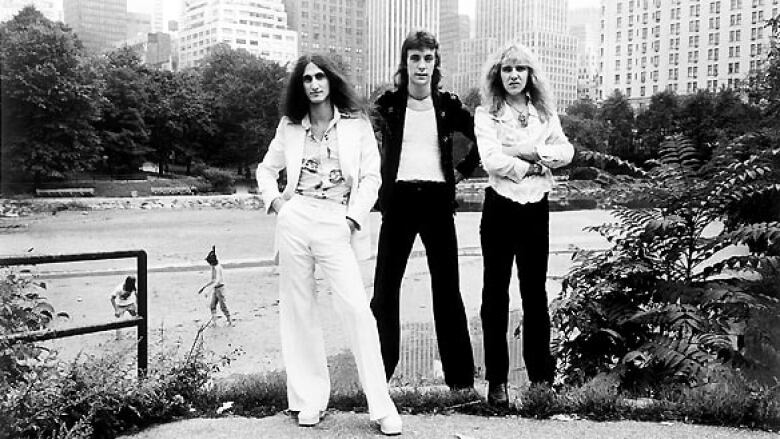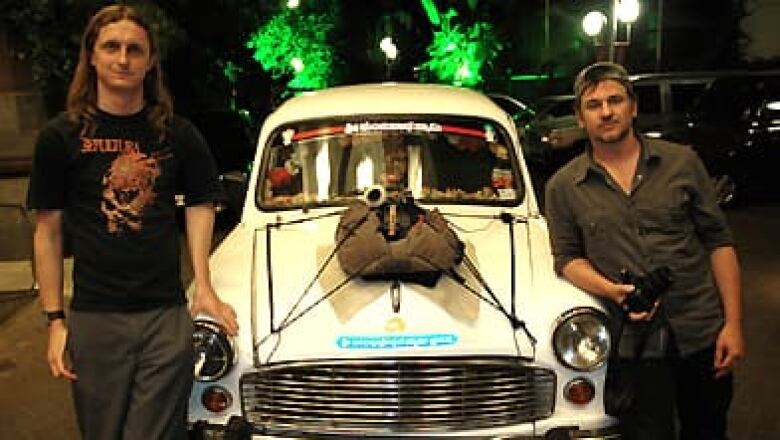Living in the limelight
Canadian rock legends Rush get the documentary treatment

The neighbourhood ofWillowdale north of Toronto is in many ways the epitome of bleakest suburbia. Monster homes, high-rise condos and boxy commercial complexes abound.
'Rush fans identify with a band that is thoughtful, reflective, a little more nuanced than your typical rock band. Theyre just not served by the Metallicas and Slayers of the world.' Sam Dunn, co-director of Rush: Beyond the Lighted Stage
To millions of fans around the world, though, this dreary segment of the Greater Toronto Area represents a rock n roll mecca. For it was in Willowdale in May of 1971 that the rock band Rush was born. At the time, the neighbourhood was even sleepier than it is today: a dull, grey sprawl of ranch-style bungalows, modest pre-war dwellings and sad-looking strip malls.
To borrow a line from aRush song, "the suburbs have no charms to soothe / the restless dreams of youth." But thats where childhood friends Alex Lifeson and Geddy Lee developed their astounding musical chops, while jamming in Lees basement. Not too far away, a misfit named Neil Peart was earning a reputation as the best drummer in the town ofHagersville, in southern Ontario. For Peart, a gangly wisp of a kid with a shy streak, his skills on the skins were a lifeline and eventually, his ticket out. After their original drummer resigned, Lifeson and Lee brought Peart on board as the third member of what would become one of the most commercially successful groups in history.
"The mythology of rock n roll comes out of London and New York and places like that," says Scot McFadyen, one of the directors behind Rush: Beyond the Lighted Stage, a new documentary about the legacy of the Canadian band. "The fact that people around the world are gonna be talking about Willowdale and A.Y. Jackson [Secondary School] thats really cool. Its our part in building Canadian mythology."
Co-directed withSam Dunn, Beyond the Lighted Stage tells the story of Rush through archival material, intimate interviews with Lee, Lifeson and (a strikingly open) Peart and testimonials from diehard Rush fans. They include the famous (Billy Corgan, South Parks Matt Stone, a hilarious Sebastian Bach) and the fanatical (the pasty-looking fellas who congregate at the annual RushCon). As the filmmakers attest, the bands fans posed one of the greatest challenges.
"Rush fans are serious, and theyre serious collectors," Dunn explains. "Theyre the band you know, as it says on the poster. We didnt want to tell the same old story and show the same old images of this band. We wanted to tell a more human, personal story about this band, and not the same old rock-star narrative."
Dunn, who holds an MA in Anthropology from York University, is used to sifting through cultural ephemera to reveal untold stories. He and McFadyen previously collaborated on exhaustive investigations of heavy metal (Metal: A Headbangers Journey and Global Metal), and produced another epic band documentary, last years Juno-winning Iron Maiden: Flight 666. But the illuminating footage and photos the two dug up for Beyond the Lighted Stage aided by a crack team of researchers is in a whole new league.

In one clip, borrowed from the lateAllan King s documentary Come On Children (a 1973 study of teens across Canada), a sulky adolescent Lifeson bickers with his anxious parents across the dinner table, trying to make a case for why he should quit school. We see the band in its pre-Peart incarnation (with original drummer John Rutsey, who passed away in 2008), trying to rock an auditorium of bellbottomed kids at Laura Secord Secondary School in St. Catharines, Ont. We also watch as Peart, Lifeson and Lee looking a little like extras from Monty Python and the Holy Grail hash out theinsane progressive-rock epics from Hemispheres (1978) at the medieval-lookingRockfield Studios in Wales.
Yet the film doesnt get bogged down in aint-that-cool show-and-tell. Its remarkable the degree to which Dunn and McFadyen are able to provide new insights into each band members personality. Who knew these guys were so goofy and garrulous? And who knew they wore their geek status with such unabashed pride? As Gene Simmons from Kiss proclaims at one point, the men of Rush have never acted like conventional rock stars. Right from the get-go, they shunned groupie-shagging and carousing in favour of watching TV in their hotel rooms or in Pearts case, penning fantastical lyrics.
Because of their bookish quality and possibly because of their late-70s flirtation with kimonos as stage wear Rush were never quite accepted by the testosterone-charged metal establishment. And critics never seemed to connect with the bands penchant for lengthy solos and arcane lyrics.
"I think they didnt connect with critics because they were perceived as being pretentious," says Dunn, "Because of fantastical lyrics, really long songs, complex time signatures. But I like that quote in the film from Neil: We werent being pretentious! We werent pretending anything. This is what were into!"
That sincerity is a constant throughout the many stylistic swerves of Rushs career, from their early days asgrimy, Zeppelin-obsessed riff-rockersto purveyors ofObjectivist-inspired rock epicsto their flirtation withsynthesizers in the 80s.
"I think theres obviously a demographic of music fans out there who dont want the alpha-male, rock n roll, hyper-masculine thing," says Dunn. "Rush fans identify with a band that is thoughtful, reflective, a little more nuanced than your typical rock band. Theyre just not served by the Metallicas and Slayers of the world."
Adds McFadyen: "If you imagine, like, a Dungeons & Dragons game or something, Rush would be these kind of weird elfin, magic theres something different [about them] compared to the other people. They kind of come into the metal world, but theyre out of the metal world. Their fans are harder to find. I hate to use this word, but theyre kind of the N-word. The one with four letters."
The one that rhymes with "bird"?
McFadyen laughs. "Exactly."
Perhaps thats what makes Rush: Beyond the Lighted Stage so delightful. Though its a passionate tribute made by two devoted fans, its not a hagiography. Instead, its a complex, warts-and-all story where, despite the odds being stacked against them, a trio of lifelong nerds prosper.
Rush: Beyond the Lighted Stage screens on Apr. 29 at Apr. 30 at the Hot Docs festival in Toronto. It gets a wide, one-night release in Canada on June 10.
Sarah Liss writes about the arts for CBC News.












_(720p).jpg)


 OFFICIAL HD MUSIC VIDEO.jpg)
.jpg)



























































































